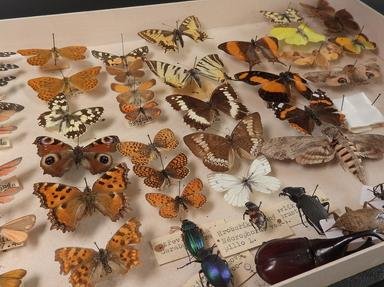Quiz Answer Key and Fun Facts
1. In the state of Florida, there are 3 species of large predatory fly. They belong to the genus "Mallophora", and are known as "bee killers". The Florida bee killer, black bee killer and Southern bee killer are some of the more well known flies. By what other name are these flies more commonly known?
2. This 'fly' is from the sub-order Anisoptera (uneven wings) and is not really a true fly. In Great Britain there are about 30 different species that still exist and one that, unfortunately, is extinct. These 'flies' are considered valuable insects by the agricultural community for their depredation of mosquitoes and other small insects. So, which 'fly' is the one I have just described?
3. There is a fly that is believed to carry over 100 pathogens that are harmful to humans. The adult can be identified easily from the four black narrow stripes along the side of the thorax, and the flaming red coloured eyes. You can tell which is male and which is female as the female has a bigger space between her eyes. So, name the fly I have just described?
4. These flies are generally bigger than deer flies. They live on the blood of their host, the horse, though they have been known to bite humans. Which fly could be described as a hippophage?
5. Known as a hover fly in England, these insects have a different name in the New World. They are considered to be of economic importance to agriculture for their feasting on aphids and for pollination. So, which fly would you want in your garden?
6. From the family Sarcophagidae comes this charming fellow. They got their name from laying their eggs within the open wounds of mammals. Normally when you see scenes on film of a writhing mass of maggots they are the young of this fly. Which fly is it?
7. From the family Simulidae comes the fly otherwise known as buffalo gnat, turkey gnat and white socks. They are known to spread river blindness in Africa by transmitting a nematode which causes the disease. What is the name of this insect which has state and federal governments, out to control it?
8. This particular insect has me running for the nearest book to swat it. These metallic blue, green or black in colour insects are heard before they are seen. Commonly called a "bluebottle," what is its real name?
9. From the family Therevidae comes a rarely collected and secretive insect. If the film industry ever wished to make a film about a deadly natural predator they should look no further than this well named fellow. So, which fly is the subject of this question?
10. This fly resembles a wasp in appearance. From the family Stratiomyidae, these insects make life difficult for the common house fly. Which fly sounds like it would be welcome within an army base?
Source: Author
martinjudo
This quiz was reviewed by FunTrivia editor
crisw before going online.
Any errors found in FunTrivia content are routinely corrected through our feedback system.
